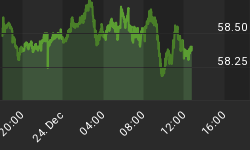Gold and silver stocks refuse to give up in spite of overhead supply from the December top and now we're seeing even some of the move actively traded junior mines are starting to rally as the upward bias in gold stock internal momentum we've talked about the last several weeks makes its presence known throughout the sector.
Although some of the XAU's price oscillators are slowly inching into positive territory and are no longer "oversold," the primary consideration right now isn't overbought versus oversold. It's the strongly rising internal momentum from a 90-day rate of change standpoint. The indicator known as GS HILMO is showing us that the dominant interim momentum for the gold and silver stock groups is strongly positive right now.
The action of Friday, Feb. 2, in the XAU index is one sign of the internal upward momentum bias I've been talking about. It has so far manifested in a refusal for gold stocks to close down too sharply, even on those days where the sellers outnumber the buyers (such as Friday) and try dampening the market's spirits.
I mentioned to you heading into February that the month ahead would likely be a volatile, rocky one at times due to the fact that the 120-day gold stock momentum indicator was down, while the 90-day momentum indicator was up strongly. These cross-currents have been responsible for what we've seen in the XAU to date. But in the near term, the 90-day momentum takes precedence over 120-day momentum (at least that's been my observation) so I expect the XAU to gradually make some headway higher this month in spite of days like Friday (which we can expect to see from time to time).
When we see white metal stocks like PAAS, SSRI and Platinum Group Metals (PTM:TSX, up 19% on Feb. 1) leading the way higher it sends a very positive vibe for the overall precious metals sector that's a little hard to ignore. While I'd rather see gold stocks leading the physical metal on the way up, I'm comforted with the relative strength and external momentum in silver stocks. When silver stocks lead it's more instructive than most indicators.

One observation that can be made is that there is a close correlation between the price movements of the oil/gas and gold/silver stock groups, and since my internal momentum indicators for both major groups are projected to rise on a 20-day, 30-day and 90-day rate of change basis in February, there should be some worthwhile trading opportunities in the leading equities within these groups.
We noted previously that the natural gas stock sector still has rally potential in February based on internal considerations as well as seasonal factors. According to Stock Trader's Almanac, February is historically bullish for the natural gas stocks. The Amex Natural Gas Index (XNG) closed Wednesday at just below the 460 level, a near term resistance. After a brief corrective pause or pullback XNG should be able to carry forward to the 470-475 resistance area in February where the previous high was made in December. Among the leading oil/gas equities with a bullish chart outlook include the following stocks: Chevron (CVX), Valero Energy (VLO), Exxon Mobil (XOM), and XTO Energy (XTO).
Privacy and freedom
The Associated Press reported this week on an issue of importance to every American. In an article by Leslie Miller ("States Challenge National Driver's License") it was stated that the Maine Legislature on Jan. 26 passed a resolution objecting to the Real ID Act of 2005, a federal law which requires states to link their record-keeping systems for driver's licenses to national databases.
Aside from its expected $11 billion implementation cost, many states are objecting to the federal identification network due to obvious invasion of privacy issues. The federal government claims the Real ID Act is in the name of fighting terrorism and restricting illegal immigration. But what the Act really amounts to, in the words of Missouri state Rep. James Guest, is a "frontal assault on the freedoms of America when they require us to carry a national ID to monitor where we are."
Despite the massive invasion of privacy the national ID proposal would bring (it also requires fingerprinting and retinal scans among other sensitive issues), and despite the fact that 34 states are in opposition to it, it's obvious the federal government desperately wants this anti-privacy measure. And what the feds want they usually get eventually.

The feds can force a national ID on Americans in one of two ways: by using the two of the most potent weapons known to man: fear or greed. The "fear" route would involve orchestrating another 911-type terrorist attack somewhere on U.S. soil. The "greed" route would involve engineering a massive economic boom/stock market bubble similar to the one of the late 1990s. If the Clinton years taught the feds anything it is that government can expand is purview over the citizenry by leaps and bounds if only a distraction is provided in the form of financial wealth (remember, "It's the economy stupid!"). An acceleration of the economic/stock market boom wouldn't be too difficult to achieve given the level of money supply creation the Fed is currently engendering. Of these two options, the "greed" route (i.e., bull market continuation) is the one most likely to be chosen by the feds for setting up Americans for the acceptance of the coming national ID card. Investors take note!
















